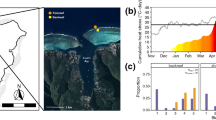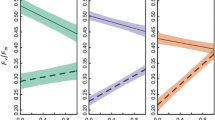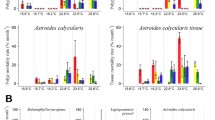Abstract
Ocean acidification changes the carbonate chemistry of seawater in a manner that reduces the biomineralisation rate of reef-building corals. Other effects of acidification on coral physiology are less well explored, and recent debate has focused on whether ocean acidification causes a change in Symbiodinium densities within tropical and subtropical reef-building corals. Within the framework of null-hypothesis significance testing, some aquaria experiments have provided evidence for a decrease in symbiont densities within coral tissue under ocean acidification (whilst others have suggested an increase). However, null effects have prevailed in the majority of such experiments, and so the question has remained unresolved. This study attempted to resolve this question using a meta-analytic framework, by establishing the effect sizes for symbiont density change under ocean acidification from a structured search of the literature. A regression of effect size (Hedge’s d) versus level of ocean acidification revealed a statistically significant negative relationship, with symbiont density per cm2 decreasing as the level of ocean acidification increased. The decline amounted to an additional 0.07 standard deviations of difference in symbiont density between corals in control (near present day) and acidified seawater with every 100 μatm of increase in partial pressure of CO2 in seawater (a relationship with an r2 of 0.24). A further unresolved question is whether ocean acidification will synergistically exacerbate (or diminish) symbiont density reductions caused by elevated temperature. An analysis of covariance did not reveal a greater decline in symbiont densities with increasing acidification at elevated temperature compared to non-stressful temperature, though this latter analysis should be viewed as exploratory due to a lower sample size. The well-supported evidence for a decline in symbiont densities in tropical and subtropical corals under ocean acidification now provides an impetus for sustained investigation of the consequences of such a change for holobiont functioning and the broader function of the coral reef ecosystem.


Similar content being viewed by others
References
Anlauf H, D’Croz L, O’Dea A (2011) A corrosive concoction: the combined effects of ocean warming and acidification on the early growth of a stony coral are multiplicative. J Exp Mar Biol Ecol 397:13–20
Anthony KRN, Kline DI, Diaz-Pulido G, Dove S, Hoegh-Guldberg O (2008) Ocean acidification causes bleaching and productivity loss in coral reef builders. Proc Natl Acad Sci USA 105:17442–17446
Baghdasarian G, Osberg A, Mihora D, Putnam H, Gates RD, Edmunds PJ (2017) Effects of temperature and pCO2 on population regulation of Symbiodinium spp. in a tropical reef coral. Biol Bull 232:123–139
Baird ME, Timko PG, Wu L (2007) The effect of packaging of chlorophyll within phytoplankton and light scattering in a coupled physical–biological ocean model. Mar Freshw Res 58:966–981
Barker S, Higgins JA, Elderfield H (2003) The future of the carbon cycle: review, calcification response, ballast and feedback on atmospheric CO2. Philos Trans R Soc Math Phys Eng Sci 361:1977–1999
Bedwell-Ivers HE, Koch MS, Peach KE, Joles L, Dutra E, Manfrino C (2017) The role of in hospite zooxanthellae photophysiology and reef chemistry on elevated pCO2 effects in two branching Caribbean corals: Acropora cervicornis and Porites divaricata. ICES J Mar Sci 74:1103–1112
Bhagooli R (2013) Inhibition of Calvin–Benson cycle suppresses the repair of photosystem II in Symbiodinium: implications for coral bleaching. Hydrobiologia 714:183–190
Borell EM, Steinke M, Horwitz R, Fine M (2014) Increasing pCO2 correlates with low concentrations of intracellular dimethylsulfoniopropionate in the sea anemone Anemonia viridis. Ecol Evol 4:441–449
Buxton L, Takahashi S, Hill R, Ralph PJ (2012) Variability in the primary site of photosynthetic damage in Symbiodinium sp. (Dinophyceae) exposed to thermal stress. J Phycol 48:117–126
Camp EF, Smith DJ, Evenhuis C, Enochs I, Manzello D, Woodcock S, Suggett DJ (2016) Acclimatization to high-variance habitats does not enhance physiological tolerance of two key Caribbean corals to future temperature and pH. Proc R Soc B 283:20160442
Coe R (2002) It’s the effect size, stupid. What effect size is and why it is important. Paper presented at the Annual Conference of the British Educational Research Association, University of Exeter, England, 12–14 September 2002
Colombo-Pallotta MF, Rodríguez-Román A, Iglesias-Prieto R (2010) Calcification in bleached and unbleached Montastraea faveolata: evaluating the role of oxygen and glycerol. Coral Reefs 29:899–907
Crawley A, Kline DI, Dunn S, Anthony K, Dove S (2010) The effect of ocean acidification on symbiont photorespiration and productivity in Acropora formosa. Glob Change Biol 16:851–863
Cunning R, Baker AC (2013) Excess algal symbionts increase the susceptibility of reef corals to bleaching. Nat Clim Change 3:259–262
Dunn SR, Bythell JC, Le Tissier MDA, Burnett WJ, Thomason JC (2002) Programmed cell death and cell necrosis activity during hyperthermic stress-induced bleaching of the symbiotic sea anemone Aiptasia sp. J Exp Mar Biol Ecol 272:29–53
Duyens LNM (1956) The flattering of the absorption spectrum of suspensions, as compared to that of solutions. Biochim Biophys Acta 19:1–12
Enríquez S, Méndez ER, Iglesias-Prieto R (2005) Multiple scattering on coral skeletons enhances light absorption by symbiotic algae. Limnol Oceanogr 50:1025–1032
Erez J (1978) Vital effect on stable-isotope composition seen in foraminifera and coral skeletons. Nature 273:199–202
Fitt WK, McFarland FK, Warner ME, Chilcoat GC (2000) Seasonal patterns of tissue biomass and densities of symbiotic dinoflagellates in reef corals and relation to coral bleaching. Limnol Oceanogr 45:677–685
Furla P, Galgani I, Durand I, Allemand D (2000) Sources and mechanisms of inorganic carbon transport for coral calcification and photosynthesis. J Exp Biol 203:3445–3457
Gabay Y, Benayahu Y, Fine M (2013) Does elevated pCO2 affect reef octocorals? Ecol Evol 3:465–473
Gibbin EM, Davy SK (2014) The photo-physiological response of a model cnidarian–dinoflagellate symbiosis to CO2-induced acidification at the cellular level. J Exp Mar Biol Ecol 457:1–7
Goreau TF (1977) Coral skeletal chemistry: physiological and environmental regulation of stable isotopes and trace metals in Montastrea annularis. Proc R Soc B Biol Sci 196:291–315
Graham ER, Sanders RW (2016) Species-specific photosynthetic responses of symbiotic zoanthids to thermal stress and ocean acidification. Mar Ecol 37:442–458
Graham ER, Parekh A, Devassy RK, Sanders RW (2015) Carbonic anhydrase activity changes in response to increased temperature and pCO2 in Symbiodinium–zoanthid associations. J Exp Mar Biol Ecol 473:218–226
Harrison F (2011) Getting started with meta-analysis. Methods Ecol Evol 2:1–10
Hii Y-S, Bolong AMA, Yang T-T, Liew H-C (2009) Effect of elevated carbon dioxide on two scleractinian corals: Porites cylindrica (Dana, 1846) and Galaxea fascicularis (Linnaeus, 1767). J Mar Biol 2009:1–7
Holcomb M, Tambutté E, Allemand D, Tambutté S (2014) Light enhanced calcification in Stylophora pistillata: effects of glucose, glycerol and oxygen. PeerJ 2:e375
Horwitz R, Fine M (2014) High CO2 detrimentally affects tissue regeneration of Red Sea corals. Coral Reefs 33:819–829
Jokiel PL (2011a) The reef coral two compartment proton flux model: a new approach relating tissue-level physiological processes to gross corallum morphology. J Exp Mar Biol Ecol 409:1–12
Jokiel PL (2011b) Ocean acidification and control of reef coral calcification by boundary layer limitation of proton flux. Bull Mar Sci 87:639–657
Jones RJ, Hoegh-Guldberg O, Larkum AWD, Schreiber U (1998) Temperature-induced bleaching of corals begins with impairment of the CO2 fixation mechanism in zooxanthellae. Plant Cell Environ 21:1219–1230
Kaniewska P, Campbell PR, Kline DI, Rodriguez-Lanetty M, Miller DJ, Dove S, Hoegh-Guldberg O (2012) Major cellular and physiological impacts of ocean acidification on a reef building coral. PLoS ONE 7:e34659
Kleypas JA, Buddemeier RW, Archer D, Gattuso J-P, Langdon C, Opdyke BN (1999) Geochemical consequences of increased atmospheric carbon dioxide on coral reefs. Science 284:118–120
Krief S, Hendy EJ, Fine M, Yam R, Meibom A, Foster GL, Shemesh A (2010) Physiological and isotopic responses of scleractinian corals to ocean acidification. Geochim Cosmochim Acta 74:4988–5001
Levas S, Grottoli AG, Schoepf V, Aschaffenburg M, Baumann J, Bauer JE, Warner ME (2016) Can heterotrophic uptake of dissolved organic carbon and zooplankton mitigate carbon budget deficits in annually bleached corals? Coral Reefs 35:495–506
Lewis DH, Smith DC (1971) The autotrophic nutrition of symbiotic marine coelenterates with special reference to hermatypic corals. I. Movement of photosynthetic products between the symbionts. Proc R Soc Lond B Biol Sci 178:111–129
Lumley T, Diehr P, Emerson S, Chen L (2002) The importance of the normality assumption in large public health data sets. Annu Rev Public Health 23:151–169
Mackey K, Morris JJ, Morel F, Kranz S (2015) Response of photosynthesis to ocean acidification. Oceanography 25:74–91
Mason RAB (2018) Symbiont densities of tropical and subtropical scleractinian corals under ocean acidification. Harvard Dataverse, V1, UNF:6:nDoNF6i90FQREdv5heBjqQ==. https://doi.org/10.7910/DVN/HMGNSP
McCulloch M, Falter J, Trotter J, Montagna P (2012) Coral resilience to ocean acidification and global warming through pH up-regulation. Nat Clim Change 2:623–627
Meron D, Buia M-C, Fine M, Banin E (2013) Changes in microbial communities associated with the sea anemone Anemonia viridis in a natural pH gradient. Microb Ecol 65:269–276
Miller CB, Wheeler PA (2012) Biological oceanography. Wiley-Blackwell, Chichester
Muscatine L, Porter JW, Kaplan IR (1989) Resource partitioning by reef corals as determined from stable isotope composition. Mar Biol 100:185–193
Nakagawa S, Cuthill IC (2007) Effect size, confidence interval and statistical significance: a practical guide for biologists. Biol Rev 82:591–605
Pollet TV, van der Meij L (2017) To remove or not to remove: the impact of outlier handling on significance testing in testosterone data. Adapt Hum Behav Physiol 3:43–60
Prézelin BB (1987) Photosynthetic physiology of dinoflagellates. In: Taylor FJR (ed) The biology of dinoflagellates. Blackwell Scientific Publishers, Oxford, pp 174–223
R Core Team (2016) R: a language and environment for statistical computing. R Foundation for Statistical Computing, Vienna. https://www.R-project.org/
Reynaud S, Leclercq N, Romaine-Lioud S, Ferrier-Pages C, Jaubert J, Gattuso JP (2003) Interacting effects of CO2 partial pressure and temperature on photosynthesis and calcification in a scleractinian coral. Glob Change Biol 9:1660–1668
Rix L, de Goeij JM, van Oevelen D, Struck U, Al-Horani FA, Wild C, Naumann MS (2017) Differential recycling of coral and algal dissolved organic matter via the sponge loop. Funct Ecol 31:778–789
Rodolfo-Metalpa R, Martin S, Ferrier-Pages C, Gattuso JP (2010) Response of the temperate coral Cladocora caespitosa to mid- and long-term exposure to pCO2 and temperature levels projected for the year 2100 AD. Biogeosciences 7:289–300
Schoepf V, Grottoli AG, Warner ME, Cai W-J, Melman TF, Hoadley KD, Pettay DT, Hu X, Li Q, Xu H, Wang Y, Matsui Y, Baumann JH (2013) Coral energy reserves and calcification in a high-CO2 world at two temperatures. PLoS ONE 8:e75049
Suggett DJ, Hall-Spencer JM, Rodolfo-Metalpa R, Boatman TG, Payton R, Tye Pettay D, Johnson VR, Warner ME, Lawson T (2012) Sea anemones may thrive in a high CO2 world. Glob Change Biol 18:3015–3025
Tremblay P, Naumann M, Sikorski S, Grover R, Ferrier-Pagès C (2012) Experimental assessment of organic carbon fluxes in the scleractinian coral Stylophora pistillata during a thermal and photo stress event. Mar Ecol Prog Ser 453:63–77
Van Kleunen M, Weber E, Fischer M (2010) A meta-analysis of trait differences between invasive and non-invasive plant species. Ecol Lett 13:235–245
Vardi A, Berman-Frank I, Rozenberg T, Hadas O, Kaplan A, Levine A (1999) Programmed cell death of the dinoflagellate Peridinium gatunense is mediated by CO2 limitation and oxidative stress. Curr Biol 9:1061–1064
Wall CB, Fan TY, Edmunds PJ (2014) Ocean acidification has no effect on thermal bleaching in the coral Seriatopora caliendrum. Coral Reefs 33:119–130
Wallace CC (1999) Staghorn corals of the world: a revision of the coral genus Acropora. CSIRO Publishing, Collingwood
Weis VM, Smith GJ, Muscatine L (1989) A “CO2 supply” mechanism in zooxanthellate cnidarians: role of carbonic anhydrase. Mar Biol 100:195–202
Wijgerde T, Jurriaans S, Hoofd M, Verreth JAJ, Osinga R (2012) Oxygen and heterotrophy affect calcification of the scleractinian coral Galaxea fascicularis. PLoS ONE 7:e52702
Wild C, Huettel M, Kleuter A, Kremb SG, Rasheed MYM, Jørgensen BB (2004) Coral mucus functions as an energy carrier and particle trap in the reef ecosystem. Nature 428:66–70
Wooldridge SA (2009) A new conceptual model for the warm-water breakdown of the coral–algae endosymbiosis. Mar Freshw Res 60:483–496
Wooldridge SA (2014) Differential thermal bleaching susceptibilities amongst coral taxa: re-posing the role of the host. Coral Reefs 33:15–27
Acknowledgements
The initial idea that became this paper was generated during a Fulbright Scholarship (granting agency: Australian-American Fulbright Commission) undertaken at the Hawai‘i Institute of Marine Biology.
Author information
Authors and Affiliations
Corresponding author
Ethics declarations
Conflict of interest
The author states that there is no conflict of interest.
Additional information
Topic Editor Dr. Mark R. Patterson
Electronic supplementary material
Below is the link to the electronic supplementary material.
Rights and permissions
About this article
Cite this article
Mason, R.A.B. Decline in symbiont densities of tropical and subtropical scleractinian corals under ocean acidification. Coral Reefs 37, 945–953 (2018). https://doi.org/10.1007/s00338-018-1720-z
Received:
Accepted:
Published:
Issue Date:
DOI: https://doi.org/10.1007/s00338-018-1720-z




